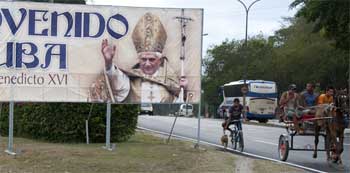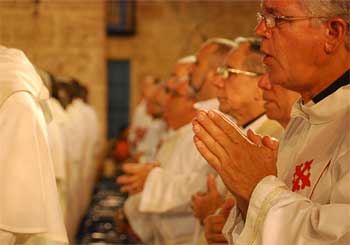Cuba: Church & State, Alliances & Resentments

HAVANA TIMES, March 22 — Cuba will soon experience its second papal visit, and many people are wondering why this small island is receiving such a privilege from Rome if, after all, the Cuban Catholic Church doesn’t have the popular support that’s seen in other countries of the region and world.
It’s even stranger because the historic leader of the revolution was excommunicated in 1962 and still remains outside the Lord’s fold. Apparently the Vatican will not forgive Fidel Castro for his conversion from Catholicism to a Marxist atheist.
Nonetheless, both the Comandante and John Paul II were able to get past that dark detail of the past and made the first visit by a Pope to Cuba (1998) an event that, in one way or another, benefited both parties.
Many of my colleagues who came here to cover that trip had enormous expectations about its political implications, but they were overlooking the facts that Cubans aren’t Poles, they’re not predominantly Catholic and the only trade union that exists here supports the government.
I remember when I was broadcasting the arrival of John Paul II live for BBC, my colleagues asked me to talk with some of the people who were crowded along both sides of Boyeros Avenue, the route that connects the airport with the capital city.
I chose an over 60-year-old woman who was standing with a group of nuns. I gave here the cellphone and my colleague in London asked her why she was there. “It’s because I’m a member of the party and Fidel asked us to welcome the Pope warmly,” she replied.
The Comandante had previously spoke for six hours on the national television calling for all party members to attend the Mass, and also trying to clean up the image of John Paul II from the past references about his involvement in the collapse of European communism.
Ultimately the visit was a success both for the Cuban government and for the Catholic Church, though mutual distrust remained. Things changed radically in 2008 with the official endorsement of Raul Castro as president.
The first foreign visitor received by this new head of government was Tarcisio Bertone, the Vatican Secretary of State, who later attempted to mediate a prisoner exchange with the US. The effort was unsuccessful but two years later came the release of all Cuban prisoners of conscience.
Church-state relations are now at their best since 1959. They are even better than during the visit by John Paul II, but the atmosphere isn’t the same, despite the welcome signs and the streets that lie newly paved for the Pope-mobile.
THE ALLIANCE BETWEEN CHURCH AND STATE CONTINUES TO STRENGTHEN
The island’s dissidents feel betrayed by Cardinal Ortega and the laypersons around him, who they say are encouraging all parishioners to support Raul Castro’s reforms – thereby marginalizing the opposition within the church.

In Miami, the exile press is criticizing the visit. They’re calling on Benedict XVI to meet with dissidents and have applauded the occupation of the church buildings by government opponents, though those individuals were eventually ousted by the police at the request of the Catholic Church itself.
On the island, more than a few Santeria priests were offended by being excluded from official activities around the visit. The Afro-Cuban religions are considered to have the greatest number of worshipers among the people and they believe that their being disregarded is a form of discrimination.
Among Protestants, there are some who suspect that the alliance of the church and the government will lead to the conversion of the secular state to Catholicism, a religion that already has two journals of its own and has the only center open for political debate.
The LGBT community sees the Vatican’s dogmas favoring homophobia in Cuba to the extent that it considers homosexuality a moral deviation, prohibits same-sex unions and opposes transsexual operations.
There are also communists and revolutionaries who are concerned that the government will give in to Catholic demands, allowing that church to occupy a permanent space in the national press and, especially, that the state will authorize them to open education centers.
To think that both sides will continue to make concessions to each other seems logical since the alliance is continuing to strengthen. In fact, many analysts believe that Benedict’s visit to Cuba has as its main objective to support the position of Cardinal Jaime Ortega as a negotiator.
The truth is that they (the church and the government) both need each other. The Catholic Church has such a small social base in Cuba it could only aspire to a leading national role by allying itself with the government’s power. Meanwhile for the government, it’s essential to have a partner with the international weight of the Vatican.
With a certain degree of humor in his words, a revolutionary-Catholic friend told me that it isn’t strange that the party and the church understand each other so well.
He noted that both are top-down organizations led by leaders who hold office for life and have a disciplined membership who consider themselves the paradigms of all humanity.
—–
(*) An Authorized Havana Times translation of the original published in Spanish by BBC Mundo.





